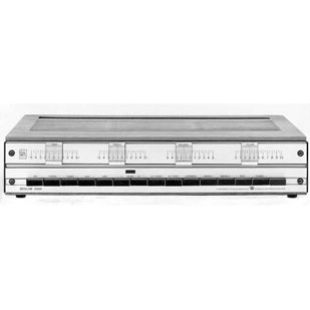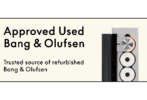
BeoLab 5000 (1969)
Design is a language which is understood by everyone…” as designer Jacob Jensen expressed it and demonstrated it in practice.” A silicon-transistor high-fidelity amplifier with less than 0.6% distortion at all frequencies and at all volume levels up to 2 x 60 watts of power output. Its signal-to-noise ratio is better than 90dB (linear measurement). […]
Overview
Design is a language which is understood by everyone…” as designer Jacob Jensen expressed it and demonstrated it in practice.”
A silicon-transistor high-fidelity amplifier with less than 0.6% distortion at all frequencies and at all volume levels up to 2 x 60 watts of power output. Its signal-to-noise ratio is better than 90dB (linear measurement). It has calibrated graphic controls and is extremely versatile, due to an unusual number of input and output facilities.
The Beolab 5000 is an amplifier that introduces no hiss or hum and reproduces all frequencies of the tonal range exactly as received. It has enormous power, permitting reproduction of even the loudest passages without distortion. Moreover, operation is logical and straightforward; varying or poor record quality can be compensated by means of efficient filters which remove the particular tonal range in which flaws are present; there is provision for connecting several speakers, including centre speaker, as well as provision for channelwise control of programme material. A special feature is a test control to facilitate adjustment of balance between channels. The use of silicon transistors ensures very low noise level, high temperature stability, and a very wide tonal range.” – taken from the 1967
Bang & Olufsen’s Beomaster 5000 FM tuner, BeoLab 5000 amplifier and Beovox 2500 Cube loudspeakers were the first product series designed by Jacob Jensen in 1967.
The traditional style for tuning knobs was replaced by an exact measuring instrument akin to the slide rule which was considered an innovation in changing the future of radios and amplifiers. The interface, in its precision and simplicity, proved to give the user optimal functionality. This solution had never been seen before and laid the foundation for the future form language of B&O. On this basis, Jacob Jensen was asked to design B&O´s audio programme. Beomaster 5000 was an FM tuner, with elimination of static between stations and a built in ‘data base’ which automatically tuned in on stereo broadcasts.
Partner to BeoLab 5000 was Beomaster 5000, an amplifier with the same slide rule interface.
The TV boom of the 1950’s hit the cinemas badly, which meant that the pressure on Bang & Olufsen’s sound engineers became less. The engineers’ love of high class sound reproduction, however, remained undiminished.
As early as the 1950s, they had developed stereo systems for the installation of Cinema-Scope systems in cinemas. In 1958, they were also responsible for the development of equipment for the first stereophonic radio transmissions from Denmark’s very first commercial radio station, Radio Mercur. When stereo started gaining ground, the engineers found new opportunities for a comeback.
The development of High Fidelity had already begun in the US and a number of small companies, headed by Scott and Fischer, had gained a dedicated following. By 1964, Bang & Olufsen was planning to conquer the new upcoming European Hi-fi market, a niche which ideally matched Bang & Olufsen’s survival strategy. Now engineers with more than 30 years’ experience behind them, under the leadership of chief engineer Nikolaj Krebs Sørensen, embarked on the development of the world’s most perfect hi-fi system, the BeoLab 5000 series.
With its ultra selective tuner and a powerful, distortion-free amplifier of no less than 2 x 60 watts, it offered qualities never seen before. The design was equally sensational. In the US, where the production of Hi-fi components had already started, they had found their form in the 19” rack format which was used by the first customers, the radio stations. When Hi-fi enthusiasts wanted quality tuners and amplifiers, they had to accept a design which belonged in the professional world.
Bang & Olufsen’s brief for the designers was: “Create a European Hi-fi format, which communicates power, precision and identity.”
This became designer Jacob Jensen and his assistant, David Lewis’ first assignment together for Bang & Olufsen. They solved it by designing the new linear controls like a slide rule bar in order to communicate the greatest possible precision. Thus began the era of the slide rule bar, a motif which was used and varied in the years to come.
The Hi-fi modules’ handles became countersunk Allen screws and the faceted and framed gold panels, which were the industry’s standard, were, in Bang & Olufsen’s design, transformed into extruded natural anodised aluminium.
BeoLab 5000 became a success, not only as Bang & Olufsen’s flagship, but also in more affordable versions, e.g.. Beomaster 1200 and 3000 and competitors were forced to follow suit. Elsewhere too, knobs were replaced by the linear slides – a development which continued until the mechanical grips were replaced by the electronic ‘easy touch’ controls of the Beomaster 1900.
At the 1967 spring fair in Hanover, B&O received the IF award for BeoLab 5000, Beomaster 5000 and Beovox 2500 Cube for outstanding and user friendly design.
Product Details
Software
No software information available.
Product Specification
Power output: 2 x 60 W
Speaker impedance: 4 ohms
Frequency range: 20 – 20,000 Hz +/- 1.5 dB
Distortion: 0.2 %
Intermodulation: 1 %
Signal-to-noise ratio: -90 dB < 60 W
– 58 < 50 mW
Bass control: +/- 17 dB 50 Hz
Treble control: +/- 14 dB 10 kHz
Outputs:
Tape DIN
Line out DIN
Line out RCA
Power supply: 110 – 130 – 220 – 240 V
Power consumption: 45 – 325 W
Dimensions W x H x D: 47 x 10 x 25cm
Weight: 10.4 kg
Connections: Inputs: DIN; MIC DIN
Phono high DIN – RCA
Phono low DIN – RCA
Tuner high DIN – RCA
Tuner low DIN – RCA
AUX DIN – RCA
Tape DIN – RCA
Downloads
Type | Language | Type | |
Brochure | EN | BeoLab 5000 User Guide | |
User Guide | EN | BeoLab 5000 User Guide | |
User Guide | EN | BeoLab 5000 User Guide | |
User Guide | EN | BeoLab 5000 User Guide | |
Setup Guide | EN | BeoLab 5000 Setup Guide | |
Service Manual | EN | BeoLab 5000 Service Manual | |
Service Manual Amplifier | EN | BeoLab 5000 Service Manual Amplifier |
Photo Gallery
No gallery images.
Frequently Asked Questions
No FAQs available.






